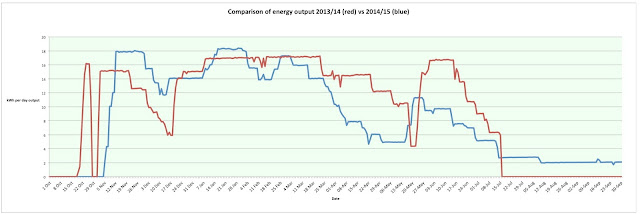Here's a type of graph which does that by presenting the data in a pleasingly simple way:
By using water years, for which the start date is 1st October, the plot lines become separated because on that date and for some time after it, there is quite a difference in the output depending on how wet the autumn here is proving to be. Thus in the graph above, water year 2 didn't see any generation until November 11th, whilst year 1 started on October 17th and year 3 carried on from the end of year 2 without a break. Once year 2 got going, generation came in strongly, as strongly as year 1, as is indicated by the same slope for the two years up to about March 18th when the line for year 2 begins to fall away from that for year 1.
The plot also shows other interesting features:
- in water year 2, generation continued throughout the 365 days of that year, unlike in water year 1 when generation had to stop on July 7th. Yet the extra number of kWh's added to the year's total by continuing to generate through the summer months was minimal: precisely 175 kWh over about 80 days. And overall the year failed to make the total of the previous year despite generation continuing through the summer.
- in water year 3, which has only just begun (green line), maximum generation has been tweaked to be slightly more than the previous two years: peak power now is 782 W as against 750 W. The result is that the slope of the green line is steeper than for the other lines and it has started to cross them as generation in year 3 accumulates kWh's ahead of the rate in the other two years. I wait with keen anticipation to see how it progresses as the year unfolds.
The target I'm hoping to hit at some time in the future is a year with 4000 kWh generated !

































